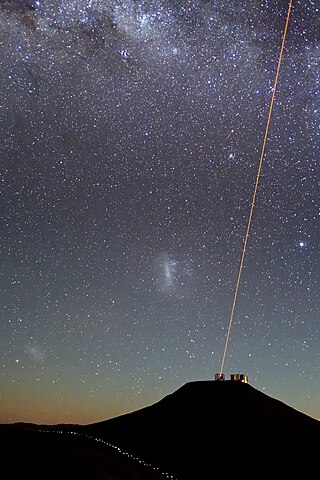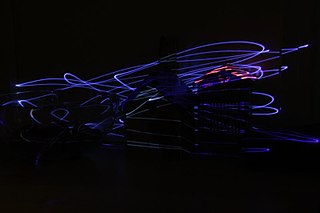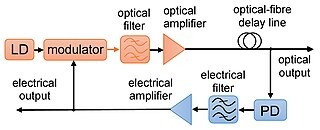
A laser is a device that emits light through a process of optical amplification based on the stimulated emission of electromagnetic radiation. The word laser is an anacronym that originated as an acronym for light amplification by stimulated emission of radiation. The first laser was built in 1960 by Theodore Maiman at Hughes Research Laboratories, based on theoretical work by Charles H. Townes and Arthur Leonard Schawlow.

An optical amplifier is a device that amplifies an optical signal directly, without the need to first convert it to an electrical signal. An optical amplifier may be thought of as a laser without an optical cavity, or one in which feedback from the cavity is suppressed. Optical amplifiers are important in optical communication and laser physics. They are used as optical repeaters in the long distance fiber-optic cables which carry much of the world's telecommunication links.

A laser diode is a semiconductor device similar to a light-emitting diode in which a diode pumped directly with electrical current can create lasing conditions at the diode's junction.

Photonics is a branch of optics that involves the application of generation, detection, and manipulation of light in the form of photons through emission, transmission, modulation, signal processing, switching, amplification, and sensing. Photonics is closely related to quantum electronics, where quantum electronics deals with the theoretical part of it while photonics deal with its engineering applications. Though covering all light's technical applications over the whole spectrum, most photonic applications are in the range of visible and near-infrared light. The term photonics developed as an outgrowth of the first practical semiconductor light emitters invented in the early 1960s and optical fibers developed in the 1970s.

A blue laser emits electromagnetic radiation with a wavelength between 400 and 500 nanometers, which the human eye sees in the visible spectrum as blue or violet.

A solid-state laser is a laser that uses a gain medium that is a solid, rather than a liquid as in dye lasers or a gas as in gas lasers. Semiconductor-based lasers are also in the solid state, but are generally considered as a separate class from solid-state lasers, called laser diodes.

An optical fiber, or optical fibre, is a flexible glass or plastic fiber that can transmit light from one end to the other. Such fibers find wide usage in fiber-optic communications, where they permit transmission over longer distances and at higher bandwidths than electrical cables. Fibers are used instead of metal wires because signals travel along them with less loss and are immune to electromagnetic interference. Fibers are also used for illumination and imaging, and are often wrapped in bundles so they may be used to carry light into, or images out of confined spaces, as in the case of a fiberscope. Specially designed fibers are also used for a variety of other applications, such as fiber optic sensors and fiber lasers.
A photonic integrated circuit (PIC) or integrated optical circuit is a microchip containing two or more photonic components that form a functioning circuit. This technology detects, generates, transports, and processes light. Photonic integrated circuits use photons as opposed to electrons that are used by electronic integrated circuits. The major difference between the two is that a photonic integrated circuit provides functions for information signals imposed on optical wavelengths typically in the visible spectrum or near-infrared (850–1650 nm).

Silicon photonics is the study and application of photonic systems which use silicon as an optical medium. The silicon is usually patterned with sub-micrometre precision, into microphotonic components. These operate in the infrared, most commonly at the 1.55 micrometre wavelength used by most fiber optic telecommunication systems. The silicon typically lies on top of a layer of silica in what is known as silicon on insulator (SOI).

Fiber-optic communication is a method of transmitting information from one place to another by sending pulses of infrared or visible light through an optical fiber. The light is a form of carrier wave that is modulated to carry information. Fiber is preferred over electrical cabling when high bandwidth, long distance, or immunity to electromagnetic interference is required. This type of communication can transmit voice, video, and telemetry through local area networks or across long distances.

IPG Photonics Corporation is a manufacturer of fiber lasers. IPG Photonics developed and commercialized optical fiber lasers, which are used in a variety of applications including materials processing, medical applications and telecommunications. IPG has manufacturing facilities in the United States, Germany, Russia and Italy.

In optoelectronics, an opto-electronic oscillator (OEO) is a circuit that produces a repetitive electronic sine wave and/or modulated optical continuous wave signals.
The IEEE Photonics Award is a Technical Field Award established by the IEEE Board of Directors in 2002. This award is presented for outstanding achievements in photonics, including work relating to: light-generation, transmission, deflection, amplification and detection and the optical/electro-optical componentry and instrumentation used to accomplish these functions. Also included are storage technologies utilizing photonics to read or write data and optical display technologies. It also extends from energy generation/propagation, communications, information processing, storage and display, biomedical and medical uses of light and measurement applications.
An optical transistor, also known as an optical switch or a light valve, is a device that switches or amplifies optical signals. Light occurring on an optical transistor's input changes the intensity of light emitted from the transistor's output while output power is supplied by an additional optical source. Since the input signal intensity may be weaker than that of the source, an optical transistor amplifies the optical signal. The device is the optical analog of the electronic transistor that forms the basis of modern electronic devices. Optical transistors provide a means to control light using only light and has applications in optical computing and fiber-optic communication networks. Such technology has the potential to exceed the speed of electronics, while conserving more power. The fastest demonstrated all-optical switching signal is 900 attoseconds, which paves the way to develop ultrafast optical transistors.
Transistor laser is a semiconductor device that functions as a transistor with an electrical output and an optical output, as opposed to the typical two electrical outputs. This optical output separates it from typical transistors and, because optical signals travel faster than electrical signals, has the potential to speed up computing immensely. Researchers who discovered the transistor laser developed a new model of Kirchhoff's current law to better model the behavior of simultaneous optical and electrical output.

Organic photonics includes the generation, emission, transmission, modulation, signal processing, switching, amplification, and detection/sensing of light, using organic optical materials.

Yasuharu Suematsu is a researcher and educator in optical communication technology. His research has included the development of Dynamic Single Mode Semiconductor Lasers for actuation and the development of high-capacity, long-distance optical fiber communications technology.

Luigi Lugiato is an Italian physicist and professor emeritus at University of Insubria (Varese/Como). He is best known for his work in theoretical nonlinear and quantum optics, and especially for the Lugiato–Lefever equation (LLE,). He has authored more than 340 scientific articles, and the textbook Nonlinear Dynamical Systems. His work has been theoretical but has stimulated a large number of important experiments in the world. It is also characterized by the fact of combining the classical and quantum aspects of optical systems.

Lightwave Electronics Corporation was a developer and manufacturer of diode-pumped solid-state lasers, and was a significant contributor to the creation and maturation of this technology. Lightwave Electronics was a technology-focused company, with diverse markets, including science and micromachining. Inventors employed by Lightwave Electronics received 51 US patents, and Lightwave Electronics products were referenced by non-affiliated inventors in 91 US patents.

Martin D. Dawson FInstP FOSA FIEEE FRSE FRS is a British professor of photonics who is research director of the Institute of Photonics at the University of Strathclyde and is Head of Fraunhofer Centre for Applied Photonics. He has made pioneering contributions in several applied photonics areas.















